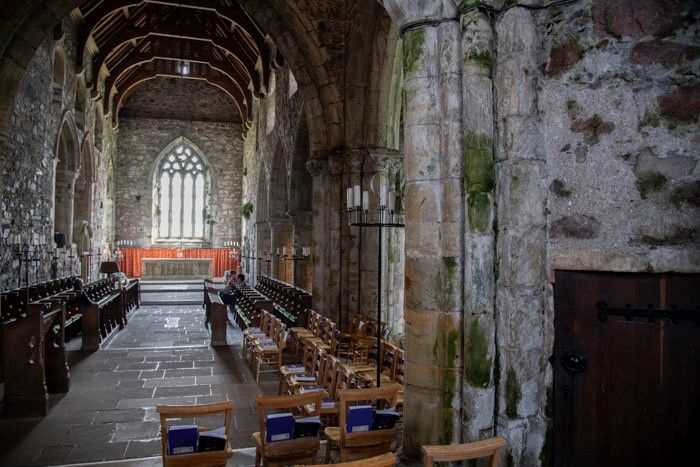Another beautiful, sunny day greeted us as we sailed from Oban to the green Isle of Mull. On the crossing, porpoises leapt out of the water in front of Lismore lighthouse and guillemots bobbed on the water around the ship. Upon arrival in the port village of Craignure, we set off on our journey across the scenic island toward Iona, situated on the end of Mulls most southerly peninsula.
A small ferry journey brought us to the island of Iona, with its wonderful sandy beaches, glorious sunshine, and adorable boats floating in the harbor. The crossing gave us wonderful views of diving gannets on both sides of the boat. Gannets are the fastest-diving bird in the northern hemisphere, capable of hitting the surface of the water at up to 70 miles per hour when diving for fish—an incredible feat of nature.
Once on Iona, we broke into groups and wandered off for a photo adventure, to see the historic Iona Abbey, or to investigate the west side of the island on a nature walk. The island is set on some of the oldest rocks on Earth—3 billion-year-old gneisses—and so has soft, rolling hills and beautiful beaches. The island’s population is around about 80.
If the ancient rocks weren’t enough, Iona has long been a destination for Christian pilgrims, since St Columba landed and set up his monastic discipline there in 563 AD. Everything about this tiny yet beautiful island is steeped in tradition and culture. After our morning walks, we went for lunch at the St. Columba Hotel and enjoyed a lovely spread of local produce.
After lunch we headed back to the ferry and to the Isle of Mull for the drive up to Duart Castle. The drive allowed us to see a very beautiful cross-section of Mull, the third largest island of the Hebrides. Behind us were the ancient rocks of Iona, as we drove between the imposing volcanic mountains. Unlike Iona, the fertile soils of Mull, protective mountains, and life-bringing river systems support swaths of forestland, both native and introduced. Finally, we were back at Craignure, where we visited the ancestral seat of the clan McClean—Duart Castle. The current clan chief, still in residence at Duart Castle, is Lachlan McClean. The castle itself is an ancient and periodically refurbished warren of rooms, all still made up in a traditional style and with walls covered in portraits of the McClean ancestors.
We enjoyed tea and scones in the modest but well-appointed tearoom before our drive up to the northern part of Mull. As the glorious summer sun drifted into haze, we traveled up alongside the Sound of Mull, headed for the most beautiful town in all the Hebrides—Tobermory. We were greeted by the welcoming line of colorful buildings that make up the Main Street as we rolled into town.
In the evening, back aboard ship, we had our evening recap on seabirds and histograms, then dinner. Afterward, a representative from the Hebridean Whale and Dolphin Trust gave a wonderful talk on the whales, dolphins, and porpoises of the Hebrides. A lovely end to a jam-packed day.







